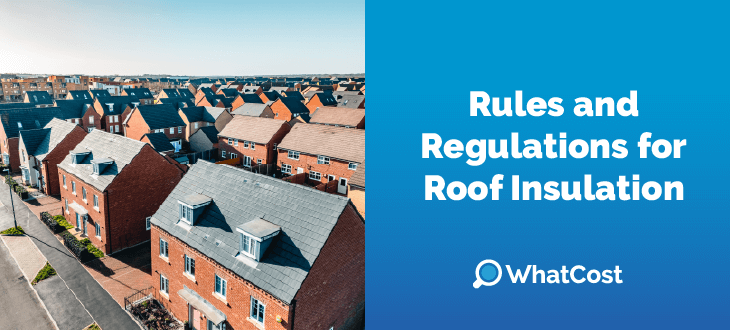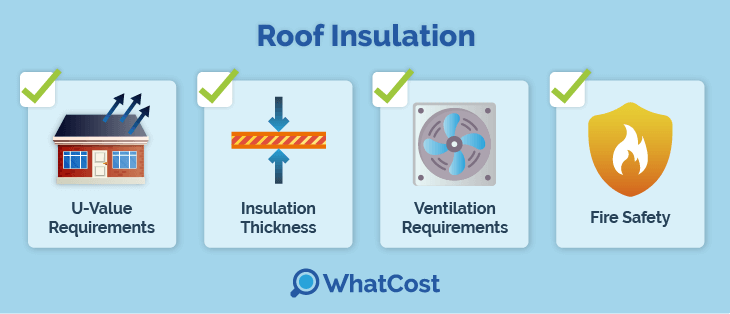Answer these simple questions and we will find you the BEST prices
Which type of solar quotes do you need?
It only takes 30 seconds
100% free with no obligation

Tell us what you need to find a matching specialist

Get free quotes from professionals near you

Compare offers and choose the one that best matches your need
- whatcost.co.uk
- Home Insulation
- Insulation Building Regulations
- Roof Insulation Building Regulations
Roof Insulation Building Regs: A Comprehensive Guide


- More than a quarter of home heat loss is caused by poorly insulated roof structures.
- Roofs are required to achieve a U-value of around 0.11 W/m²K for new builds, 0.15 W/m²K for retrofits, 0.16 W/m²K for renovations, and 0.18 W/m²K for flat roofs.
- In addition to thermal efficiency, roof insulation can increase property value, should you ever choose to rent or sell your home.
Roof insulation is one of the most important steps to improve a home's thermal efficiency. Installing effective roof insulation measures can bring you annual energy bill savings of up to £380, and carbon savings of up to 1 ton in a detached home. However, certain insulation building regulations must be followed to ensure a safe, effective and long-term solution.
This ultimate guide by WhatCost will provide a comprehensive rundown of the rules and regulations relating to insulation on roof structures, including u-value, thickness, ventilation, and safety guidelines that must be met.
Ready to insulate your roof? Book a job with WhatCost today. Instead of spending endless hours on websites and phone calls, spend just 30 seconds filling out our online form and receive up to 3 free home-tailored quotes directly from our network of trusted installers. No costs or obligations apply. Simply click below to begin!
Roof insulation building regulations in the UK

Roof insulation building regs in the UK are outlined in Part L of the UK Building Regulations. This section of the building regulations outlines the criteria that must be met for optimal performance and longevity of your roof insulation project. Let’s take a look at the key demands.
U-value requirements
The u-value of a material is the rate by which it’s able to prevent heat transfer. This means that a lower u-value indicates a better capacity for insulation. UK building regulations expect roof insulation projects to achieve a certain u-value, depending on the type of roof.
The current u-value expectations for pitched roof and flat roof insulation in the UK are:
- New builds: 0.11 W/m²K
- Retrofitting: 0.15 W/m²K
- Renovations: 0.16 W/m²K
- Flat roofs: 0.18 W/m²K
To ensure this efficiency is met, it’s recommended to work with a professional installer who is well-versed in the requirements for home insulation projects. Doing so will save you the headache of tedious research, and the strenuous labour of a DIY job.
Insulation thickness
The thickness of your chosen insulation material is important, as it relates to how much thermal efficiency you aim to achieve. For example, lower-efficiency blanket insulation materials like fibreglass require a much higher thickness to achieve the same efficiency as high-performance rigid insulation like PIR or cork. There is no single best roof insulation material, but some certainly outperform others.
Here’s a breakdown of the three popular insulation materials, and the roof insulation thickness you may require to meet the desired u-value:
| Material | New builds (0.11 W/m²K) | Retrofitting (0.15 W/m²K) | Renovations (0.16 W/m²K) |
|---|---|---|---|
| EPS polystyrene | 220-250mm | 250-280mm | 100-120mm |
| PIR board | 130-150mm | 150-170mm | 80-100mm |
| Mineral wool | 230-260mm | 260-290mm | 120-130mm |
The best way to ensure these stringent requirements are met is to conduct a housing assessment with an accredited installer. That way, a tailored plan can be made to best meet your needs most efficiently.
Ventilation requirements
A key element of ensuring a long-term roof insulation solution is keeping the insulation material dry and healthy. Avoiding excessive condensation and moisture ingress is vital to keep your material free from mould, rot and cold spots.
It is required to leave a 50mm air gap between the underlay and insulation material. This gap should be no smaller than 25mm at the centre of the underlay, 25mm at the eaves, and at least 5mm at the ridge of the pitched roof.
By ensuring adequate ventilation, you create room to make sure any vapour forming in your home can evaporate without leeching into your insulation material and damaging it. This is especially important for blanket and loose-fill insulation materials like sheep wool or cellulose that are very prone to retaining moisture.
Fire safety
Certain fire safety regulations must be followed in both warm and cold roof insulation projects. This primarily involves using insulation materials that are certified as non-combustible or have limited combustibility.
In some cases, fire-resistant membranes and barriers must be installed to further protect the roof structure and limit the risk of fire spread. The most optimal method for you will depend on your roof type and condition. Hire a professional installer to assess your structure and tailor the best course of action.
Building regulations: Cold vs warm roof insulation

UK roof insulation regulations generally impose the same requirements throughout all roof insulation projects, but can slightly differ depending on whether you are conducting a cold or warm roof insulation project. Firstly, let’s look at the difference between these two methods:
- Cold roof insulation: A cost-effective insulation for pitched roofs in which insulation material is installed over and between the joists of your loft floor, leaving the attic space uninsulated and the home below insulated. This is suitable for lofts intended as storage spaces, but not for living spaces.
- Warm roof insulation: A more costly yet effective method in which insulation material is installed directly under the roof, in between and over the roof rafters. This creates a thermal barrier that keeps the entire roof space warm, ideal for lofts converted into living spaces.
Insulating a flat roof generally follows the same procedures as cold and warm-pitched roof insulation but in a flat format. Now that we have had an introduction to the two main roof insulation approaches, let’s look at the different u-value expectations for each type of insulation:
| Roof type (existing) | U-value | Recommended approach |
|---|---|---|
| Cold-pitched roof insulation | 0.16 W/m²K | 270mm blanket insulation between loft floor joists. |
| Warm-pitched roof insulation | 0.13 W/m²K | 270mm blanket insulation between roof rafters. |
| Cold flat roof insulation | 0.18 W/m2K | 120mm of rigid insulation at ceiling level. |
| Warm flat roof insulation | 0.18 W/m²K | 120mm of rigid insulation at the structural deck level. |
How to guarantee your roof insulation meets building regulations
Guaranteeing all the tedious details of roof insulation regulations as a DIY task is a highly stressful process. Failure to follow these guidelines can result in expensive removals and reworks that exceed the costs of working with a professional.
For this reason, it’s recommended to work with a professional installer. That way, your specific home situation can be assessed, and a tailored approach can be created to suit your needs in the most financially and materially efficient manner.
Too expensive? Not to worry. The UK government has insulation grants in place to help low-income and energy-inefficient households with financial assistance. The two key grant schemes are the Great British Insulation Scheme (GBIS) and the Energy Company Obligation (ECO4). To learn more, visit the UK government website or contact your local energy provider.
With WhatCost, you can save endless time and resources by simply filling out our online intake form. All it takes is 30 seconds, and we’ll return 3 free home-tailored quotes to you at no charge or obligation to accept. Click below to begin and enjoy the best bargains from the market!
FAQ
Building regulations for roof insulation focus on key avenues that ensure your roof insulation is safe, effective and durable. Part L of the UK Building Regulations document outlines u-value requirements, insulation thicknesses, ventilation, and fire safety guidelines for both pitched and flat roof structures.
Building regs for roof insulation have minimum thickness requirements depending on your roof type, chosen material, and intended u-value. In general, it’s recommended to install up to 270mm of mineral wool or other blanket-type insulation to achieve a high u-value.

Akif has a keen interest in green home improvement solutions and the role of digital media in identifying climate trends. He aims to provide a multidisciplinary approach to content rooted in credible research and accuracy.
